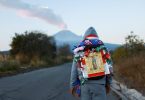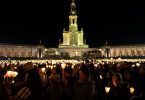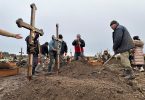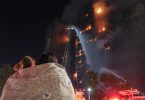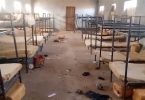
A unidentified bishop plays soccer with boys during a Jan. 7 visit in Gaza City. The bishop was part of a delegation from North America, Europe and South Africa. (CNS photo/Marcin Mazur, Bishops’ Conference of England and Wales)
By Judith Sudilovsky
JERUSALEM (CNS) — From a new playground at the Catholic parish in Gaza to transitional housing provided by a U.S. agency, visiting bishops from three continents said they saw signs of hope and resilience amid the continuing poverty and destruction in the Gaza Strip.
“There is still a lot of suffering, but I’ve seen more signs of hope. This year one of the main things [that impressed me] was this sort of hope,” said Bishop Lionel Gendron of St. Jean-Longueuil, Quebec. “There are a few signs that it is possible to rebuild in a very simple way. Last year, I thought it was truly awful; this year, hope is there.”
Bishop Gendron and church representatives from Europe, the United States and South Africa visited Gaza before the start of the Jan. 9-14 Holy Land Coordination, an annual meeting in which visiting bishops visit vulnerable Christian communities in the Holy Land.
In Gaza, still rebuilding from a 2014 war with Israel, the group visited some of the families who are using the wooden transitional housing donated by Catholic Relief Services, said Bishop Gendron.
“It might not be what there was in the past, but at least it is something, and they have a home and can live like human people,” he said. “In this Year of Mercy, the church is merciful with all the suffering of the people.”
Bishop Gendron said he was impressed by the work the church is doing through its educational institutions and noted that, of the 900 students studying in the Catholic schools, only 83 were Christians. The schools have remained coeducational despite requests by Hamas and some parents for gender-separate classes, he said.
“And yet the parents choose to send their children to the schools because they value the ethics and moral teachings that children are given at the schools,” added Archbishop Stephen Brislin of Cape Town, South Africa.
Archbishop Brislin said that, during his visit last year, months after the war that left 100,000 Gazans homeless, he found the people “hapless,” but this year saw more economic and building activity.
“The spirit seems to be a lot stronger than last year,” he said. “There is a greater sense of purpose in terms of building homes, but Gaza is still basically an open-air prison, and people feel trapped.”
He said he was most touched by speaking to young people who have limited opportunities for furthering their education and finding gainful employment in Gaza and yet are unable to leave to seek better opportunities.
“It is a waste of the giftedness of those people and what they could contribute to society,” he said, noting that he felt a sense of unity among the Gazans, Muslim and Christian.
Bishop William Nolan of Galloway, Scotland, said he came away with a sense of helplessness with the continuing desolation of the situation there. He said according to figures they were given, only 20 percent of the infrastructure destroyed in the 2014 war had been rebuilt.
“I would love to see the borders of Gaza open up and for there to be freedom of movement across the border. Keeping people fenced in that way is not good or healthy,” said Bishop Nolan. “It does not help either the Israelis or the Palestinians.”
Stephen Colecchi, director of the Office of International Justice and Peace of the U.S. Conference of Catholic Bishops, has been to Gaza six times. He said just entering into Gaza through the stringent Israeli security process and walking through a barren no-man’s-land to get to the Palestinian side is always a reminder of how isolated Gaza is from the rest of the world.
“There is more rebuilding, but it is nowhere near enough,” Colecchi said. He added that he is always struck by the people’s resilience.
“There is more economic activity than last year, and more rebuilding, but the essential situation of the people as a whole has not changed to any significant degree,” Colecchi said. “There are fruits and vegetable markets and there are lots of children everywhere, but when you speak to people you hear their discouragement and feeling of entrapment.”
He noted that, in June, the ability to import the wood needed to continue the CRS transitional housing project was hindered and, despite the bishops’ contact efforts via the U.S. State Department and the Israeli Embassy in Washington, the situation has not changed. As a result, CRS has not been able to build the homes at the rate at which they are capable.
The Christian community, though it remains small, continues to be vibrant, he added. The church officials joined the parish for two Masses during their visit, and Colecchi said it was encouraging to see young couples with children there.
The new playground built for the children on the church grounds is “a sign of the vitality of the community,” Colecchi said. “It is a symbol that the church is still investing in that community. It was obvious that the pastor and the people were very proud of the playground. It is bright and cheerful and hopeful in a grim situation.
“It is a small community, and they were incredibly grateful for our visit,” he added. “They are a minority within a beleaguered community. They let their faith sustain them to energize them to be of service.”
The Holy Land Coordination was set up at the end of the 20th century at the invitation of the Holy See to visit and support the local Christian communities in Israel, Jordan and the Palestinian territories.
The bishops — including Bishop Oscar Cantu of Las Cruces, New Mexico — were scheduled to visit and celebrate Mass with the Christian communities of the West Bank villages of Taybeh and Beit Jalla, then travel to Jordan to meet with refugees from Syria and Iraq.


